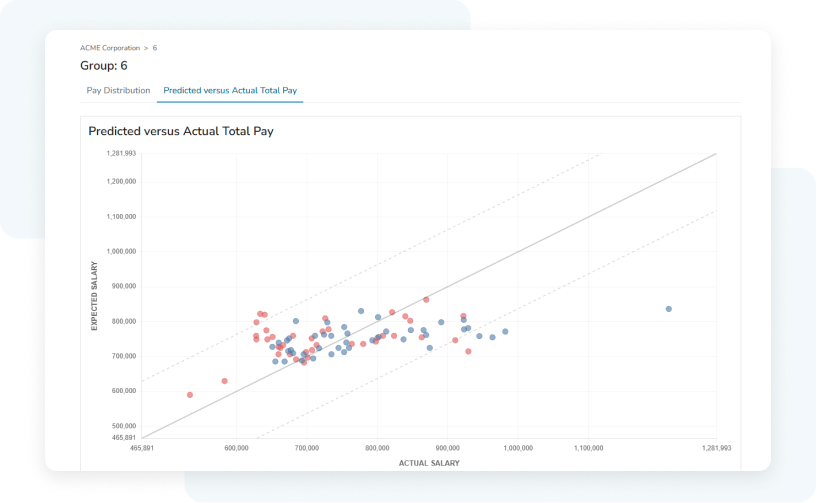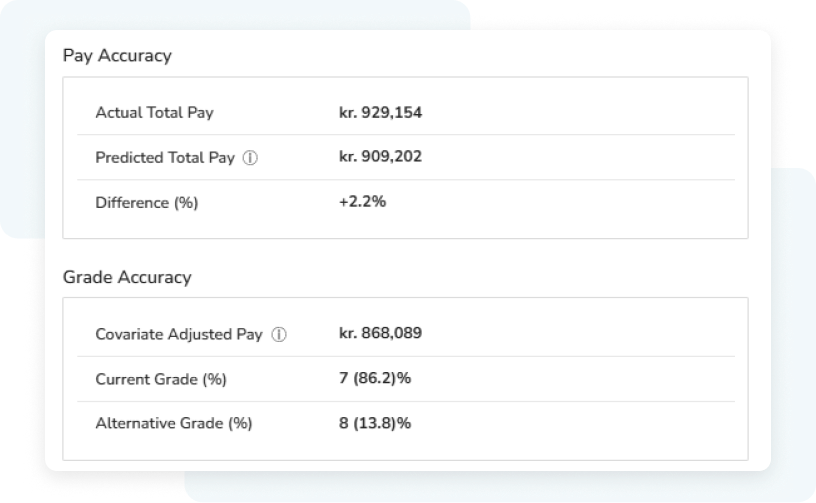Validate pay grades
Make sure pay gaps are not the result of grade outliers

Identify and correct pay grade outliers to make sure pays gaps are not the result of misclassified employees. Our AI powered grade review makes grade validation simple and accurate.
Easy outlier detection
Stop guessing which employees might be misclassified. Fairfox predicts fair pay for each role and flags employees whose actual salary is 20%+ away from the prediction - a strong signal an employee may be in the wrong grade.
Use interactive filters, drill-through and visualizations to investigate patterns and fix classifications before they become compliance issues.

AI powered grade suggestions
Move from identification to resolution with automated grade suggestions. Fairfox analyzes each outlier's profile against your grade structure to recommend optimal placement, ensuring consistent and defensible reclassification decisions.

Track equity impact
Evaluate reclassification scenarios with real-time impact analysis. Move employees between grades virtually to assess how each change affects compensation costs and equity metrics before implementing changes.

Additional Resources
Calculate fair pay
Calculate equitable pay ranges for promotions and new hires
Validate pay grades
Identify and correct outliers with our AI powered grade review tool.
Close Pay Gaps
Close pay gaps with confidence using our recommendations engine.
Frequently Asked Questions
What if someone is flagged as a grade outlier but we think they're in the right grade?
Employees are flagged based on the difference between predicted and actual pay, but you decide whether to act on that information or disregard the flag.
However, unresolved grade outliers can significantly impact your pay equity analysis and increase remediation costs.
We recommend reviewing flagged employees carefully, even if you ultimately decide they're correctly placed. Often what appears to be a pay equity issue is actually a classification problem that's much cheaper to resolve.
Can I customize the pay model to my organization?
Fairfox uses machine learning algorithms to analyze multiple factors and calculate the best grade fit for each employee. The system evaluates various data points about the employee's role and compensation patterns to determine optimal placement.
For each employee, you receive a grade fit percentage showing how well they match their current grade, plus recommendations for alternative grades with their respective fit scores. This gives you clear, data-driven guidance on whether someone is optimally placed or would be better suited in a different grade level.
The AI considers your organization's existing grade structure and compensation patterns to ensure recommendations align with your company's framework and maintain internal consistency.
What if we need to create new grades or restructure existing ones?
No problem - many companies discover their grade structure needs adjustment once they start analyzing pay equity data. Fairfox's impact tracker is designed exactly for this situation.
You can test different grade configurations and see their real-time impact on both cost and equity metrics. Want to see what happens if you split a grade into two levels? Create the new grades virtually and simulate moving employees to assess the financial and fairness impact before making any changes.
The impact tracker lets you experiment with various scenarios - adding new grades, merging existing ones, or restructuring entirely - so you can find the optimal grade structure for your organization. You'll see exactly how each change affects your compensation costs and equity metrics.
This way, you can refine your grade structure based on data rather than guesswork, ensuring it supports both fair compensation and budget requirements.
What's the ROI of fixing grade misclassifications before pay equity remediation?
The impact is substantial. Our research shows that validating grades before remediation can reduce costs by up to 60% while actually improving fairness outcomes.
Here's why: when employees are misclassified, their pay gaps often get "fixed" with salary adjustments when the real solution is simply moving them to the correct grade. This means you're spending money on raises that don't actually address bias - they just mask classification errors.
By identifying and correcting these misclassifications first, you ensure pay adjustments are only made where there's genuine evidence of bias. This dramatically reduces your remediation budget while creating a more equitable and defensible compensation structure.
The cost savings compound over time since correctly classified employees are less likely to generate false pay gaps in future analyses.
What if fixing grade classifications creates new pay gaps?
That's actually expected and a good thing - it means you're uncovering real pay equity issues that were previously hidden. Misclassified employees don't just create false pay gaps; they can also mask genuine group-level
disparities that need attention.
When you move employees to their correct grades, you might reveal pay gaps that were obscured by having people in the wrong classifications. For example, if high-paid women were incorrectly placed in lower grades, moving them up might expose that the remaining women in those grades are actually underpaid compared to their male colleagues.
This is why grade validation is a necessary first step in proper pay equity analysis. You need to see the true compensation picture before you can address real bias effectively. Any new gaps that emerge from correct classifications represent genuine equity issues that deserve remediation.
The alternative - leaving misclassifications in place to hide gaps - creates a false sense of equity while real problems persist.
Want to see how grade corrections reveal the true pay equity landscape in your organization? Let's walk through the validation process in a demo


